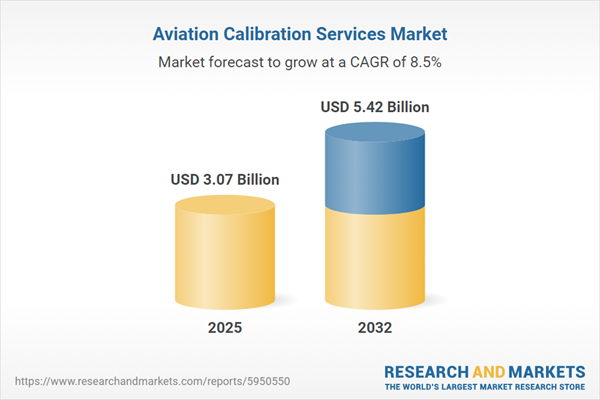Expanding Air Traffic and MRO Sector Drive Market Growth Amidst Calibration Service Challenges
Speak directly to the analyst to clarify any post sales queries you may have.
The Aviation Calibration Services Market is adapting rapidly to technological advancements, regulatory shifts, and evolving operational demands. As aviation systems grow more sophisticated, so does the need for reliable, precise calibration across all platforms—establishing calibration services as a vital element in flight safety and performance assurance.
Market Snapshot: Aviation Calibration Services Market Growth and Trends
The Aviation Calibration Services Market expanded from USD 2.82 billion in 2024 to USD 3.07 billion in 2025, projecting continued growth at an 8.50% CAGR and a forecasted value of USD 5.42 billion by 2032. This upward trajectory reflects rising global demand for calibration solutions, driven by increasingly complex avionics, stricter certification standards, and ongoing digital transformation initiatives. Modernization across commercial, business, and defense aviation sectors fuels the integration of advanced calibration tools and service models, underpinning operational dependability and regulatory compliance.
Scope & Segmentation of the Aviation Calibration Services Market
Comprehensive segmentation within the aviation calibration sector reveals a dynamic ecosystem of services, equipment, and end-user applications:
- Service Types: Laboratory calibration, mobile calibration, on-site calibration (avionics, electrical, mechanical), and software calibration.
- Equipment Types: Avionics instruments, electrical instruments, mechanical instruments, software tools.
- End-Use Industries: Business aviation, commercial aviation, military and defense.
- Calibration Methods: Automated, IoT-enabled (including AI-driven and blockchain-enabled), manual, and remote calibration.
- Service Delivery Modes: Contract calibration (long-term and short-term), on-demand calibration, scheduled calibration.
- Calibration Frequency: Predictive, reactive, and routine calibration.
- Regional Coverage: Americas (North America, Latin America), Europe, Middle East & Africa, Asia-Pacific.
Within each segment, service providers harness emerging digital tools, advanced automation, and tailored workflows to serve aviation client needs ranging from routine maintenance to operational readiness and risk mitigation across global markets.
Key Takeaways for Senior Decision-Makers
- Precision in calibration directly influences fleet uptime, regulatory compliance, and operational excellence, positioning service providers as essential partners in aviation.
- Adoption of digital platforms—such as IoT-enabled devices and blockchain-backed records—enhances process transparency and enables real-time monitoring and automated verification.
- Environmental objectives are prompting a pivot toward sustainable calibration practices, leveraging remote diagnostics and energy-efficient solutions.
- Flexible delivery models—including mobile, on-site, and software-based calibration—address diverse customer requirements and support emerging predictive maintenance strategies using advanced analytics.
- Collaboration across the value chain, including technology alliances and regional manufacturer partnerships, helps ensure agility in meeting industry challenges and adapting to regional regulatory frameworks.
Tariff Impact: Navigating New Cost and Supply Chain Challenges
Recent tariff measures announced by the United States for 2025 complicate cost structures for aviation calibration providers, particularly regarding specialized equipment imports. These developments are driving investment in domestic sourcing and the establishment of regional calibration hubs, helping to mitigate exposure to tariffs and reduce lead times. Providers are also accelerating implementation of automated and remote methods to decrease cross-border logistical burdens and enhance network resilience.
Methodology & Data Sources
This market analysis synthesizes data from primary interviews with calibration professionals, regulatory experts, and field engineers, complemented by thorough reviews of technical standards, industry publications, and peer consultations. Rigorous segmentation and regional benchmarking ensure high-quality, comprehensive insights.
Why This Report Matters
- Strategic market intelligence enables senior leaders to optimize procurement, sourcing, and technology planning for calibration solutions.
- Actionable insights on market segmentation, emerging technologies, and regulatory trends help decision-makers future-proof their organizations.
- Regional analyses and competitive profiling support investment decisions and partnership strategies in an evolving landscape.
Conclusion
As the aviation calibration services market transforms, business leaders who invest in digital workflows, predictive analytics, and strategic alliances will secure a clear advantage. This report equips stakeholders to navigate industry complexity and capitalize on evolving opportunities within the sector.
Additional Product Information:
- Purchase of this report includes 1 year online access with quarterly updates.
- This report can be updated on request. Please contact our Customer Experience team using the Ask a Question widget on our website.
Table of Contents
3. Executive Summary
4. Market Overview
7. Cumulative Impact of Artificial Intelligence 2025
Companies Mentioned
The companies profiled in this Aviation Calibration Services market report include:- Fluke Corporation
- AMETEK, Inc.
- Transcat, Inc.
- Element Materials Technology Limited
- SGS SA
- Intertek Group plc
- TÜV SÜD AG
- TÜV Rheinland AG
- Mettler-Toledo International Inc.
- Bureau Veritas SA
Table Information
| Report Attribute | Details |
|---|---|
| No. of Pages | 186 |
| Published | October 2025 |
| Forecast Period | 2025 - 2032 |
| Estimated Market Value ( USD | $ 3.07 Billion |
| Forecasted Market Value ( USD | $ 5.42 Billion |
| Compound Annual Growth Rate | 8.5% |
| Regions Covered | Global |
| No. of Companies Mentioned | 11 |









